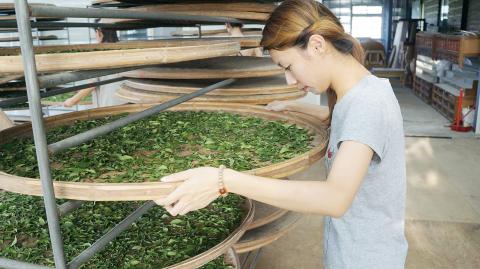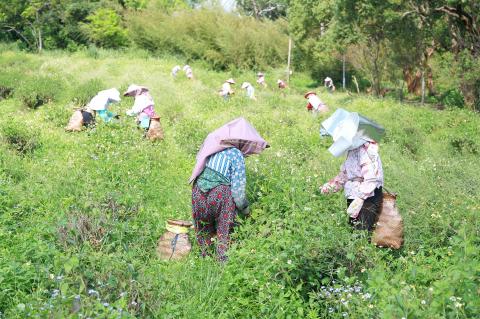Well known for its oriental beauty tea and bitter orange tea, the Rixin tea plantation in Miaoli County’s Toufen Township has been around for 100 years and is now under the management of fourth-generation owner Hsu Shih-wen. In recent years, he has been striving to transform the farm’s operations, making use of the slack season to let members of the public experience the whole process of making tea, and thereby enabling the continued development of the Hakka tea-making industry.
When you walk onto the Rixin plantation, you can see elderly women tea-pickers wearing sun-shading clothes made of Hakka floral fabric and carrying tea baskets on their backs, fully equipped for the job as they carefully pick “one tip and two leaves.” The beautiful tea-garden scene is reminiscent of Millet’s world-famous painting The Gleaners, and now other people have the opportunity to blend into this evocative picture.
As well as classic traditional Hakka bitter orange tea, Hsu has been using organic, toxin-free extensive farming methods to produce oriental beauty tea that enjoys wide renown. His persistence in organic farming allowed the plantation to get through the recent scare over toxic tea.

Photo: Cheng Hung-ta, Liberty Times
照片:自由時報記者鄭鴻達
To give everyone a chance to find out more about the tea industry, Hsu makes use of the slack season between July and November each year to welcome tourists and let them take part in tea activities all the way from picking the leaves, sunning and indoor withering through to the final stages of tossing, hot-air drying and tea-tasting. Then people can take the finished product home to brew and drink. This is how Hsu is applying new ways of thinking to market this century-old tea farm.
(Liberty Times, translated by Julian Clegg)
位於苗栗縣頭份鎮,以東方美人茶、酸柑茶聞名的日新茶園已有百年歷史,現由第四代園主許時穩經營。他近年力圖轉型,利用秋冬農閒之際,開放民眾體驗全程製茶過程,讓客家製茶產業繼續發揚光大。
走入日新茶園,可見採茶阿婆穿著客家花布圖樣的防曬衣物,背著竹編茶簍,「全副武裝」專注地挽摘著一心二葉,宛如世界名圖米勒「拾穗」般,構成一幅茶園美景。如今民眾也有機會,融入這幅充滿意境的畫面當中。

Photo: Cheng Hung-ta, Liberty Times
照片:自由時報記者鄭鴻達
除了經典傳統的客家酸柑茶,許時穩也以有機無毒粗放管理方式,產製聞名遐邇的東方美人茶。也因堅持有機,讓茶園挺過先前的毒茶風暴。
許時穩為了讓大眾更了解茶產業,利用每年七到十一月農閒季節,接待遊客,讓遊客從採茶、曬茶、日光及室內萎凋,到最後的浪茶、烘茶、品茶,親自參與,並將成品帶回泡來喝,以新思維行銷百年茶園。
(自由時報記者鄭鴻達)

The Dutch introduced the Indian mango (Mangifera indica) to Taiwan in the 17th century. It is a green-skinned mango with thick fibers that get stuck in the teeth, but it boasts a rich aroma and a unique taste. In 1954, Taiwan’s Council of Agriculture introduced several mango cultivars from Florida, USA, including the Irwin, Haden, and Keitt varieties. After seven years of testing and domestication, the Irwin variety was chosen for promotion. Years later, the sample saplings started to bear fruit. These mangoes were large, with thin, vibrant red peels and golden pulp. The Irwin mangoes were mouth-wateringly sweet and

As the priest Antonius Hambroek stood in the dim chamber of Fort Zeelandia, his eldest daughter clung to him, her voice trembling. “Father, don’t go. They’ll kill you, and what will become of Mother and my sisters?” Outside, the sounds of Koxinga’s relentless canon siege boomed through the fortress. The defenders were on the brink of collapse. Starvation gnawed at their resolve, and the air carried the acrid stench of spent gunpowder and rotting flesh. Dutch reinforcements from Batavia had failed to arrive, leaving the garrison isolated and hopeless. Hambroek’s face was calm, though sorrow weighed heavily on his